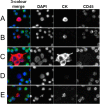Analytical Validation and Capabilities of the Epic CTC Platform: Enrichment-Free Circulating Tumour Cell Detection and Characterization
- PMID: 28936239
- PMCID: PMC5572988
- DOI: 10.5772/60725
Analytical Validation and Capabilities of the Epic CTC Platform: Enrichment-Free Circulating Tumour Cell Detection and Characterization
Abstract
The Epic Platform was developed for the unbiased detection and molecular characterization of circulating tumour cells (CTCs). Here, we report assay performance data, including accuracy, linearity, specificity and intra/inter-assay precision of CTC enumeration in healthy donor (HD) blood samples spiked with varying concentrations of cancer cell line controls (CLCs). Additionally, we demonstrate clinical feasibility for CTC detection in a small cohort of metastatic castrate-resistant prostate cancer (mCRPC) patients. The Epic Platform demonstrated accuracy, linearity and sensitivity for the enumeration of all CLC concentrations tested. Furthermore, we established the precision between multiple operators and slide staining batches and assay specificity showing zero CTCs detected in 18 healthy donor samples. In a clinical feasibility study, at least one traditional CTC/mL (CK+, CD45-, and intact nuclei) was detected in 89 % of 44 mCRPC samples, whereas 100 % of samples had CTCs enumerated if additional CTC subpopulations (CK-/CD45- and CK+ apoptotic CTCs) were included in the analysis. In addition to presenting Epic Platform's performance with respect to CTC enumeration, we provide examples of its integrated downstream capabilities, including protein biomarker expression and downstream genomic analyses at single cell resolution.
Keywords: Analytical Validation; Biomarker; CTC; CTM; Circulating Tumour Cells; Clinical Feasibility; Epic CTC Platform; Fluid Biopsy; Liquid Biopsy; Metastasis.
Figures





Similar articles
-
Analytical validation of the CellMax platform for early detection of cancer by enumeration of rare circulating tumor cells.J Circ Biomark. 2019 Dec 31;8:1849454419899214. doi: 10.1177/1849454419899214. eCollection 2019 Jan-Dec. J Circ Biomark. 2019. PMID: 31921364 Free PMC article.
-
Chromosomal Instability Estimation Based on Next Generation Sequencing and Single Cell Genome Wide Copy Number Variation Analysis.PLoS One. 2016 Nov 16;11(11):e0165089. doi: 10.1371/journal.pone.0165089. eCollection 2016. PLoS One. 2016. PMID: 27851748 Free PMC article.
-
Detection and Characterization of Circulating Tumour Cells from Frozen Peripheral Blood Mononuclear Cells.J Circ Biomark. 2015 May 13;4:4. doi: 10.5772/60745. eCollection 2015 Jan-Dec. J Circ Biomark. 2015. PMID: 28936240 Free PMC article.
-
Circulating tumor cells: a multifunctional biomarker.Clin Cancer Res. 2014 May 15;20(10):2553-68. doi: 10.1158/1078-0432.CCR-13-2664. Clin Cancer Res. 2014. PMID: 24831278 Review.
-
Exploration of Circulating Tumour Cell (CTC) Biology: A Paradigm Shift in Liquid Biopsy.Indian J Clin Biochem. 2021 Apr;36(2):131-142. doi: 10.1007/s12291-020-00923-4. Epub 2020 Sep 16. Indian J Clin Biochem. 2021. PMID: 33867703 Free PMC article. Review.
Cited by
-
Development and validation of circulating tumour cell enumeration (Epic Sciences) as a prognostic biomarker in men with metastatic castration-resistant prostate cancer.Eur J Cancer. 2021 Jun;150:83-94. doi: 10.1016/j.ejca.2021.02.042. Epub 2021 Apr 21. Eur J Cancer. 2021. PMID: 33894633 Free PMC article.
-
Integration of Liquid Biopsies in Clinical Management of Metastatic Prostate Cancer.Curr Oncol Rep. 2022 Oct;24(10):1287-1298. doi: 10.1007/s11912-022-01278-0. Epub 2022 May 16. Curr Oncol Rep. 2022. PMID: 35575959 Free PMC article. Review.
-
A Systematic Review of Circulating Tumor Cells Clinical Application in Prostate Cancer Diagnosis.Cancers (Basel). 2022 Aug 4;14(15):3802. doi: 10.3390/cancers14153802. Cancers (Basel). 2022. PMID: 35954464 Free PMC article. Review.
-
Circulating tumor cell-based or tissue biopsy-based AR-V7 detection: which provides the greatest clinical utility?Ann Transl Med. 2019 Dec;7(Suppl 8):S354. doi: 10.21037/atm.2019.09.92. Ann Transl Med. 2019. PMID: 32016072 Free PMC article. No abstract available.
-
Lessons Learned: Transfer of the High-Definition Circulating Tumor Cell Assay Platform to Development as a Commercialized Clinical Assay Platform.Clin Pharmacol Ther. 2017 Nov;102(5):777-785. doi: 10.1002/cpt.645. Epub 2017 Mar 22. Clin Pharmacol Ther. 2017. PMID: 28160285 Free PMC article. Review.
References
-
- Gupta G P and Massague J (2006) Cancer metastasis: Building a framework. Cell. 127: 679–95 - PubMed
-
- Chaffer C L and Weinberg R A (2011) A perspective on cancer cell metastasis. Science. 331: 1559–64 - PubMed
-
- Hanahan D and Weinberg R A (2011) Hallmarks of cancer: The next generation. Cell. 144: 646–74 - PubMed
-
- Yu M Bardia A Wittner B S Stott S L Smas M E Ting D T Isakoff S J Ciciliano J C Wells M N Shah A M Concannon K F Donaldson M C Sequist L V Brachtel E Sgroi D Baselga J Ramaswamy S Toner M Haber D A and Maheswaran S (2013) Circulating breast tumor cells exhibit dynamic changes in epithelial and mesenchymal composition. Science. 339: 580–4 - PMC - PubMed
LinkOut - more resources
Full Text Sources
Other Literature Sources
Research Materials
Miscellaneous

